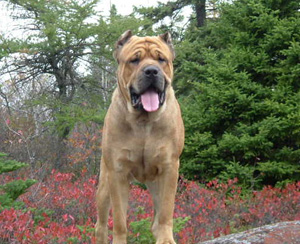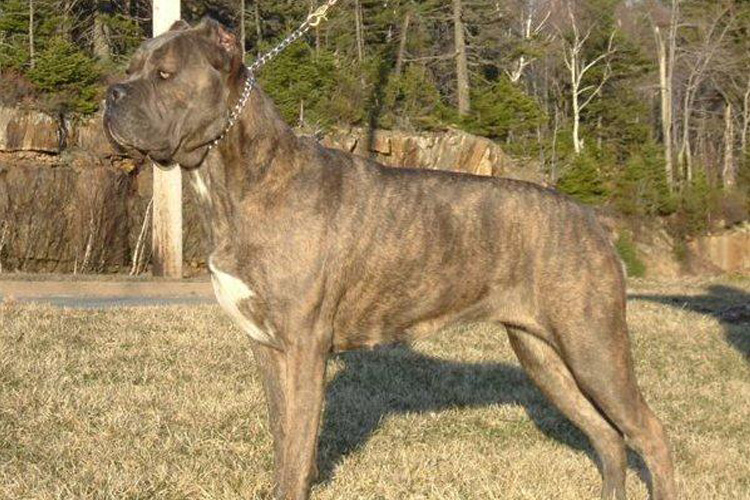
Cane Corso
Group: Working Dog Group
Origin: Italy
Height:
- – Male: 24 to 27 inches (62-68 cm)
– Female: 22 to 25 inches (58-64 cm).
Weight:
- – Male: 92 to 120 lbs (42-50 kg)
– Female: 80 to 100 lbs. (38-45 kg).
Also Known As: Cane Corso Italiano; Italian Mastiff
Pronounced: KAH-neh KOR-soh
CLICK HERE to View Breeder Listings
Breed Profile
The Cane Corso is an Italian breed and the direct descendant of the Roman Molossian. For centuries Cane Corsos have been outstanding guardians of property, family and livestock. They defended the herds from large predators such as wolves and bears and they have also been used to hunt wild boar, stag and bear.
The Cane Corso is intelligent, stable and active. His movement is powerful and effortless and he is considered to be unmatched as a watchdog. While affectionate with his family and loving to children, if necessary, he becomes a brave protector of both his family and property. Though wary of strangers, he should never be aggressive. The true Corso is indifferent when approached by strangers and will only react if a real threat is present. According to the FCI Breed Standard, an aggressive, unfriendly, or unapproachable Corso is incorrect.
Corsos enjoy many varied activities, including: weight pulling, carting, agility, flyball, herding and tracking.
A Bit of Breed History
The Cane Corso is a direct descendant of the ancient Roman Molossian “Canis Pugnax.” The breed first appeared in the sixteenth century and was used in the hunting of large game as well as an “auxiliary warrior” in battles. Later, the breed also worked as a farmhand, flock guardian, property and family guardian.
The breed was common throughout Italy until Industrialization and, by the end of World War II, the breed had declined to a point of being considered very rare. By the 1970s, only a few dogs remained in remote areas of Southern Italy. In 1974, Dr. Paolo Breber took an interest in the breed and after acquiring some of the remaining dogs, he began a breeding program. By 1996, the breed had achieved recognition by the Federation Cynologique Internationale (FCI).
During this time, some of the dogs had been imported to the United States and the International Cane Corso Federation (ICCF) was formed. In 2003 the ICCF began seeking AKC recognition and the Cane Corso Association of America was formed. In July 2010 the breed achieved official recognition by the American Kennel Club in the Working Group.
In Canada, the Cane Corso is in the process of gaining full recognition by the Canadian Kennel club and is currently a Listed Breed under the Working Dogs group.
Health Issues
Like all breeds of dogs, the Cane Corso may be affected by certain health disorders, including:
- Heart Disease — There are several types of Cardiac diseases believed to be caused by genetic factors and some of which have been reported in the Cane Corso breed, including: Cardiomyopathy, Sub-Aortic Stenosis (SAS), and Tricuspid Valve Dysplasia (TVD).
- Hip Dysplasia — Canine Hip Dysplasia is one of the primary health problems found in Cane Corsos.
- Elbow Dysplasia
- Epilepsy
- Eye Problems — The Cane Corso is a breed of Mastiff and thus has eye problems common to his relatives. The most common defects are entropion, ectropion, and cherry eye.
- Thyroid Problems
- Bloat — As with many of the large and giant breeds, the occurrence of Bloat or Gastric Torsion is a real possibility in the Cane Corso. If you are not familiar with this condition, it is absolutely necessary to learn about it and know the symptoms — This is a real emergency and a life threatening condition that requires immediate Veterinary attention. See Gastric Dilatation Volvulus (GDV) — Bloat in the Health and Nutrition section of Canada’s Guide to Dogs for more information and First Aid for Bloat for an article describing some of the things you can do if you are faced with this situation.
If you are considering the adoption of a Cane Corse puppy, or any breed, it is very important to be selective in choosing a responsible and reputable breeder. Ensure that the prospective puppy’s parents have all health clearances. Breeding of any dog should not be done until after they have been proven to be free of evidence of significant hereditary diseases. (For more information on selecting a breeder, see the articles on the General Information page.)
Additional Health Resources:
- Health and Nutrition — Growing section of the Canada’s Guide to Dogs website which includes information on several health and nutrition related issues.
- Canine Health Information Center (CHIC) — Providing a source of health information for owners, breeders, and scientists that will assist in breeding healthy dogs. CHIC is a centralized canine health database jointly sponsored by the AKC/Canine Health Foundation (AKC/CHF) and the Orthopedic Foundation for Animals (OFA).
- AKC Canine Health Foundation — Working towards developing scientific advances in canine health.
- OFA – Companion Animal Eye Registry (CAER)
- Orthopedic Foundation for Animals (OFA)
- Ontario Veterinary College (OVC)
- University of Pennsylvania Hip Improvement Program (PennHip)
- HealthGene — HealthGene Corporation is the leading provider of veterinary DNA diagnostic services in Canada.
- Labgenvet — Laboratory of Veterinary Genetics is a Canadian diagnostic laboratory that offers a comprehensive service of DNA tests for veterinary genetic diseases.
Breed Standards
- CKC Breed Standard – Listed Breed Working Dogs Group
- AKC Breed Standard
- UKC Breed Standard
- FCI-Standard No. 343 – (Italian Cane Corso)
Note: Registration of the Cane Corso — In the United States, the majority of Cane Corsos are registered with the International Cane Corso Federation (ICCF). Cane Corsos that are imported from Italy should have ENCI registrations. ENCI is the Fédération Cynologicue Internationale (FCI) recognized registry in Italy. (Note that the FCI is not a registry but each FCI country of origin maintains it’s own registry.)
Did You Know?
- Pronounced: KAH-neh KOR-soh
- The Cane Corso name derives from the Latin word “cohors”, which means “protector, guardian of the farmyard.”
- The Cane Corso breed originated in Italy.
- The Cane Corso has a free flowing and powerful gait with strong reach and drive.
- As a protector of property and family, the Cane Corso is unequaled.
Grooming Information
- Grooming — This section of the Canada’s Guide to Dogs website includes tips, articles and information covering all aspects of dog grooming along with a listing of Groomers from across Canada.
Training Resources
The Cane Corso is a strong and dominant natured breed. Therefore, the role of leader must be established from a young age. Early socialization and training are very important for this breed.
- Training — For training information, see this growing section of the Canada’s Guide to Dogs website for tips, articles, as well as listings of training centres across Canada.
Additional Information
- Is a Cane Corso Right for Me? — From the Cane Corso Association of America
- Clubs, Sports & Activities — For information on the many sports and activities you can get involved in with your dog.
- Working Dogs — The Working Dogs section of the Canada’s Guide to Dogs website provides information and listings of organizations that are involved in various dog jobs, such as Guide Dogs, Therapy Dogs, Police Dogs, Protection Dogs, and much more.
*NOTE 1: CHIC – The Canine Health Information Center “is a database of consolidated health screening results from multiple sources. Co-sponsored by the Orthopedic Foundation for Animals (OFA) and the American Kennel Club (AKC) Canine Health Foundation, CHIC works with parent clubs to identify health screening protocols appropriate for individual breeds. Dogs tested in accordance with the parent club established requirements, that have their results registered and made available in the public domain are issued CHIC numbers.” To learn more, visit: www.caninehealthinfo.org
*NOTE 2: The Fédération Cynologique International (FCI) is the World Canine Organization, which includes 91 members and contract partners (one member per country) that each issue their own pedigrees and train their own judges. The FCI recognizes 344 breeds, with each being the “property” of a specific country. The “owner” countries write the standards of these breeds in co-operation with the Standards and Scientific Commissions of the FCI, and the translation and updating are carried out by the FCI. The FCI is not a breed registry nor does it issue pedigrees.
Breed Listing
Quick Links
Get In Touch
- Email: canadasguidetodogs@gmail.com
- Email: info@canadasguidetodogs.com
- Visit us on Facebook: www.facebook.com/CanadasGuideToDogs
— CanadasGuideToDogs.com is an Amazon Associate as well as a participant in various affiliate programs, as such fees are earned from qualifying purchases.



